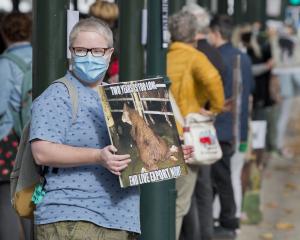The full story of the disaster in Dhaka is still to emerge, but it's clear that the eight-storey Rana Plaza complex, housing more than 3000 garment workers, had been shoddily built and was visibly unsafe.
Reports suggest large cracks were spotted in the walls, and jolts felt in the structure, shortly before its collapse, and warnings were given about its fragility. Rather than heed these, however, owners of the companies using the building appear to have ordered (in some cases with threats) staff to work as normal, with the consequence that nearly 400 workers are now known to be dead, with 900 more still trapped under the concrete and dust.
Doubtless there will be action to punish those responsible and tighten up the regulations governing factory operations in Bangladesh - but this is not the first time employees in Bangladesh's booming garment industry have died because of unsafe working conditions. In November last year, a fire at a clothing factory in another suburb of Dhaka claimed the lives of 112 people, and in April 2005 the collapse of a factory not far from the Rana Plaza killed 73 garment workers.
The conditions under which garment workers are employed in Bangladesh - including low pay, long hours and lax health and safety and building regulations - make it attractive to many global clothing brands. In barely a decade, Bangladesh has become the second-largest clothing exporter in the world after China, with that industry employing about 4 million people and accounting for 80% of the country's $US24 billion ($NZ28 billion) annual exports. Yet, its minimum wage is the equivalent of about $NZ11 a week for workers spending long shifts in effectively sweat-shop conditions.
Writing in Time magazine last week, journalist Charlie Campbell made a telling point. While the big brand names will challenge allegations that their supply chain goes back to companies using the Rana Plaza, Mr Campbell wrote, ''what is not in dispute ... is the cruel reality of the global rag trade: in order for consumers in developed economies to enjoy tasteful clothes at affordable prices, low-paid workers in countries like Bangladesh must toil in dangerous, sometimes lethal, conditions''.
Mr Campbell isn't saying that all of us in the developed world should experience deep pangs of guilt whenever we buy new clothes. Yet the inconvenient truth is that, while companies outsourcing production to developing countries have a moral responsibility for the workers in their chain, we, as consumers, cannot be entirely blame-free either.
It is not that it is ''wrong'' to want the best possible deal when we buy our clothes, and in these economically straitened times most of us simply cannot afford to pay over the odds anyway. But we've now reached the point where some clothes cost as little as a take-away pizza or burger and fries, and we ought at least to be asking questions about what that involves. Simple market logic says that anything at a rock-bottom price will have been produced by someone earning a rock-bottom wage.
We could argue that most of the clothing made at the Rana Plaza retails in North America and Europe, though some of the labels linked to the building are available here. But the more important point is that we do not - and cannot - know where all our clothes are sourced. One consequence of globalisation is that many of the commodities we buy, including clothes, consist of materials produced and processed in many different parts of the world. As ''ethical fashion'' blogger Amy Stephens writes, even shopkeepers will not know where their merchandise is sourced and ''look at you like you're an alien'' if you ask them!
Yet there are things we can do including, if we can afford it, seeking out New Zealand-made and ethically-sourced clothing. This is not easy, since even companies which have ''ethical policies'' on their websites don't clearly identify their ''ethical'' lines on the shop floor. But advice about ethical shopping is available online, and, as the ODT reminded us in a feature last November on young entrepreneurs, Dunedin even has its own ethical clothes and jewellery boutique, the Cuckoo's Nest, run by two university students.
Buying ethically will not change the world overnight, but, as we've seen with the fair trade movement, when enough of us make ''fair-traded'' products like tea, coffee, chocolate and bananas our default choice, the impact on producers in the developing world is profound. Next week sees the beginning of Fair Trade Fortnight, the annual celebration - and reminder - of the difference fair trade makes.
In a famous sermon preached in Dunedin in 1888, the Rev Rutherford Waddell condemned what he called ''the sin of cheapness'' and the harsh conditions in which garment makers worked in the city to satisfy popular demand for low-priced goods. Thanks to his efforts, we've moved a long way towards making such conditions a thing of the past in New Zealand. There is still work to do, however, if they are to be eradicated altogether.
• Andrew Bradstock is director of the Centre for Theology and Public Issues at the University of Otago.
[This article was initially published with an incorrect headline. The error has been corrected - Online ODT]












